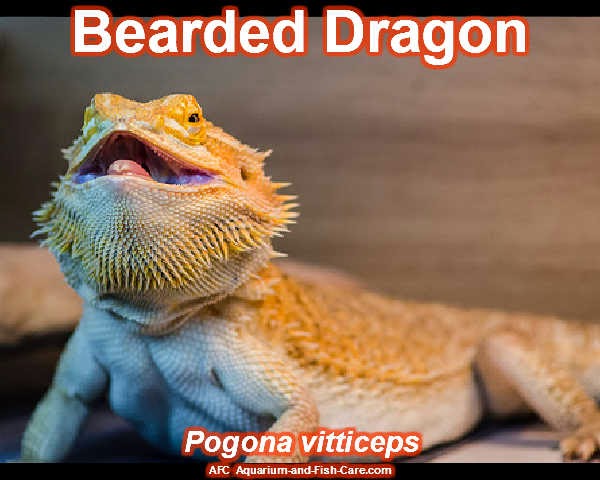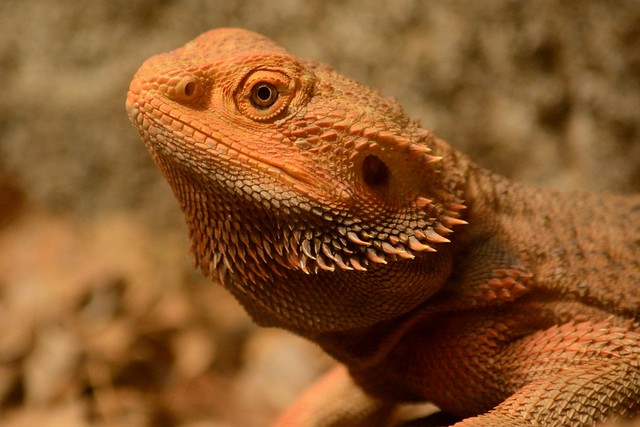 |
| Bearded Dragon - Pogona vitticeps |
2017-10-25
2017-10-23
Common Types Of BEARDED DRAGONS
 |
| Bearded Dragon - Photo by jdnx |
All species of bearded dragons are popular because of their quiet nature, ease of handling, and their small size to name just a few. Unlike many reptiles, bearded dragons require a much smaller space to live comfortably in, and are easily handled by adults, and children. There are eight different species of bearded dragons noted in Australia, and the following 6 are the most commonly known as pets.
The Western Bearded Dragon
The western bearded dragon is mainly found on the southwest coast and inland areas of Western Australia. It lives mainly in woodland areas, as well as in coastal dunes, and in the desert as well.
The Inland Bearded Dragon
The inland bearded dragon is the largest of all the species and grows to around 20cm in size. This species is found in every state, and territory of Australia except for Western Australia. The inland bearded dragon is the most popular breed of reptilian pet.
The Mitchells Bearded Dragon
The Mitchells bearded dragon is found in the interior of the Northern Territory, and in the north of Western Australia in the Great Sandy Dessert. The Mitchells species is the smallest of the bearded dragon species and grows to around 14cm. One of the easiest ways to tell a Mitchells bearded dragon apart from the other species is his large cone-like head spikes, which are unlike any of the other bearded dragons.
The Dwarf Bearded Dragon
The dwarf-bearded dragons, considered to be closely related to the Mitchell species, are mainly found in the Great Sandy Desert. The dwarf dragon is easily Identifiable because of his short legs, and short tail.
Lawsons Bearded Dragons
The Lawsons bearded dragons are the second most popular pet species. This species lives in most of Queensland, and some of the Northern Territory, but how much area the species actually occupies is still unknown.
The Nullabor Bearded Dragon
The Nullabor bearded dragon is a very rare species found only in a small area between the South Western, and South Australia. The Nullabor bearded dragon is easily recognizable by its markings, with large white markings along its back, and spines on its sides. The Nullabor bearded dragon is the least likely of all of the bearded dragons to be kept as pets, as they are hard to find in the wild, and have been known to be very difficult to breed in captivity.
is the least likely of all of the bearded dragons to be kept as pets, as they are hard to find in the wild, and have been known to be very difficult to breed in captivity.
It is possible that there are still undiscovered species of bearded dragons in Australia, as well as subspecies, as much of Australia's reptilian wildlife is still being discovered today.
|
2017-10-22
2017-10-21
2017-10-20
The Top Seven Ways To CONTROL ALGAE In A Freshwater Aquarium
 |
| Pterygoplichthys multiradiatus (Syn. Liposarcus multiradiatus) (Photo credit: Wikipedia) |
- Change the Water - Regular water changes are necessary to keep fish healthy. During water changes use a gravel vacuum to remove some of the water while you suck out fish waste and excess food from the gravel. Since excess waste is converted by bacteria into Nitrates and Nitrates are a food for alga, vacuuming the gravel removes one of its sources of food. Also, vacuuming the gravel will physically remove some the unsightly mess by turning the gravel under. This vacuum action buries algae-covered gravel so it no longer can receive light. Without light, it will die.
- Physical removal - Algae can be physically removed from the glass by wiping it with an aquarium sponge, algae magnet or scraper (razor blade scrapers work well.) Large rocks, driftwood, artificial plants, etc., can be treated outside the aquarium in a bucket containing a 10% bleach solution. It is important to rinse and dry them thoroughly before putting them back into the tank.
- Natural Algae Control - Light is a key factor for algae growth. Fish only aquariums (aquariums without live plants) do not require lot of light compared to the intense light needed in order for live aquarium plants to flourish. For fish only aquariums, make sure there is enough light to see your fish; if you add bright light you will spend much time cleaning the glass and equipment.
- Reduce Light Time - How long your light is turned on is another factor for algae growth. Generally, run lights 6 to 10 hours a day for fish only aquariums. Live planted aquariums require light from 8 to 12 hours each day. To control excess algae growth in a fish only aquarium simply shorten the number of hours the lights remain on.
- Appliance Timers - An appliance timer is great for turning aquarium lights on and off at specified times. A timer removes human error so that the lights are not left on when you are out all night partying or fall asleep on the couch!
- Live Controllers - There are several varieties of fish that eat algae. A few of the best choices are Otocincluss, Siamensis, and Plecostomus. Otocincluss are great for small aquariums as they grow to only to 2 inches in length. The Siamensis is another great choice -, especially for live planted tanks. One of the most popular algae eaters is the plecostomus (pleco for short.) The plecos seen most often for sale in pet and aquarium stores can grow over a foot long. A better choice for most is a clown or albino Bushy Nose Plecostomus as these fish grow to a mere four and four and a half inches long, respectively.
- Chemical Treatment - There are several commercial algaecides which are safe for fish. If you keep live plants, read algaecide labels and follow directions carefully. Some algaecides can be harmful to live plants.
A final tip is to not to overfeed your fish. Excess food is not only bad for the health of your fish, it is also broken down by good bacteria, becoming a source of food for algae.
Following these tips will keep your aquarium looking beautiful for longer times between cleanings. For more expert tips and advice on setting up, keeping and maintaining a freshwater aquarium, and much more, click here http://aquaticexperts.com/products/ Laurren Schmoyer owned one of the largest aquarium stores on the East Coast for over 25 years. He also owned an aquarium service company for over 28 years. He has spent many years teaching and training customers the experts' way to keep all types of aquariums healthy and thriving for years. Article Source: EzineArticles |
2017-10-19
Subscribe to:
Posts (Atom)




